A Medium- and Long-Term Orderly Charging Load Planning Method for Electric Vehicles in Residential Areas
Abstract
:1. Introduction
- (1)
- To propose a forecasting mathematical model of the charging load for RAs;
- (2)
- To develop a hierarchical load optimization method for analyzing the impact of orderly charging on the overall load level of the residential distribution network;
- (3)
- To present a new typical analysis method for the daily load characteristics of urban RAs.
2. Architecture of Orderly Charging Load Planning in RAs
3. Forecasting EV Charging Load in RAs
3.1. The Ownership of EVs
3.2. Charging Probability Model
- I.
- Travel Characteristics
- II.
- Charging Time
3.3. Forecasting of Charging Load
- (1)
- The maximum market potential, innovation coefficient p, and imitation coefficient q of EVs are selected, and the Bass model is used to iterate the medium- and long-term ownership of EVs in RAs;
- (2)
- According to the established mathematical model of EV travel characteristics, a large number of samples are randomly selected;
- (3)
- Using Equations (7) and (8), the charging start SOC and charging time of each random sample is calculated;
- (4)
- Determine whether each random sample is in the charging state at each moment;
- (5)
- According to the results of step (4), the daily charging probability curve of EVs in RAs is obtained;
- (6)
- Cycle the above steps (2) to (5) 100 times to obtain the average value curve of the daily charging probability of EVs;
- (7)
- Multiply the number of medium- and long-term EVs obtained in step (1) with the EV charging probability obtained in step (6), to obtain the number of charging EVs at each moment;
- (8)
- The number of charging EVs at each moment in step (7) is multiplied by the charging power to obtain the EV charging load power in RAs.
4. Orderly Charging Strategy for EVs in RAs
4.1. Orderly Charging Optimization of Distribution Network
- I.
- Objective Function
- II.
- Constraints
4.2. Node Orderly Charging Optimization
- I.
- Objective Function
- II.
- Constraints
4.3. Nonlinear Optimization
5. Case Analysis
5.1. Simulation Parameters
5.2. Simulation Result
6. Conclusions
- (1)
- For the optimization of the distribution network layer, when using orderly charging, the overall peak–valley difference and peak load of the RA does not exceed the daily peak load until the target year.
- (2)
- For the optimization of each access node, the charging load power will be shifted after the implementation of the orderly charging strategy. The total peak load of the EV access node may be bigger than the peak power of disorderly charging depending on the number of EV access nodes and the shifted charging load power. The orderly charging load of each EV access node can provide a data basis for the future planning of charging facilities in RAs.
- (3)
- Implementation of orderly charging can improve the voltage quality of the distribution network in RAs and can reduce the network loss. With the increasing proportion of EV charging electricity, distribution network planning considering orderly charging can effectively save investment and operation costs.
Author Contributions
Funding
Institutional Review Board Statement
Informed Consent Statement
Data Availability Statement
Conflicts of Interest
Nomenclature
| Parameter | Description |
| g | Ratio of newly added products to the largest market potential [-] |
| G | Ratio of the total cumulative products to the largest market potential [-] |
| p | Innovation coefficient [-] |
| q | Imitation coefficient [-] |
| h | Private vehicle ownership growth rate [-] |
| fwd-w | Probability density function at the work travel end time in the weekdays [-] |
| fwd-s | Probability density function at the end time of the weekday shopping and social travel [-] |
| fwe-s | Probability density function at the end time of the weekend shopping and social travel [-] |
| L | Probability density function of a single mileage [-] |
| l | Mileage of the vehicle in a single travel [km] |
| μs | Expectation of lnl [km] |
| σs | Standard deviation of lnl [km] |
| SOC0 | Starting SOC of the electric vehicle charging [%] |
| dj | Mileage of the j-th travel [km] |
| D | Maximum mileage of the electric vehicle [km] |
| tc | Charging time of the electric vehicle [hour] |
| E | Battery capacity of the electric vehicle [kW·h] |
| Pc | Charging power [kW] |
| F | Objective function of the upper level [-] |
| PEV | Charging load [kW] |
| Pnorm | Conventional electricity load [kW] |
| P | Average value of the overall load [kW] |
| tww-open | Start time of orderly charging of electric vehicles for work travels on workdays [hour] |
| tww-end | End time of orderly charging of electric vehicles for work travels on workdays [hour] |
| tss1-open | Start time of orderly charging of electric vehicles for shopping and social travel on weekdays [hour] |
| tss1-end | End time of orderly charging of electric vehicles for shopping and social travel on weekdays [hour] |
| tss2-open | Start time of orderly charging of electric vehicles for shopping and social travel on weekends [hour] |
| tss2-end | End time of orderly charging of electric vehicles for shopping and social travel on weekends [hour] |
| Cmax | Maximum capacity of the residential distribution network [kVA] |
| EEV | Electric vehicle charging electricity in each hour [kW·h] |
| Esum | Total charging electricity [kW·h] |
| fj | Load variance of the node j [-] |
| pEV-j | Electric vehicle charging load of the node j [kW] |
| pnorm-j | Conventional daily load of the node j [kW] |
| Pj | Average value load of the node j [kW] |
| EEV-j | Electric vehicle charging electricity of the node j in each hour [kW·h] |
| Esum-j | Charging electricity of the node j [kW·h] |
| Cj-max | Maximum capacity of the node j [kVA] |
Appendix A
| Node Number | Node Injected Active Power (kW) | Node Injected Reactive Power (kVar) | Node Capacity(kVA) |
|---|---|---|---|
| 1 | - | - | - |
| 2 | 100 | 30 | 400 |
| 3 | 90 | 25 | 400 |
| 4 | 120 | 35 | 400 |
| 5 | 60 | 15 | 400 |
| 6 | 60 | 15 | 400 |
| 7 | 200 | 60 | 400 |
| 8 | 200 | 60 | 400 |
| 9 | 60 | 15 | 400 |
| 10 | 60 | 15 | 400 |
| 11 | 45 | 10 | 400 |
| 12 | 60 | 15 | 400 |
| 13 | 60 | 15 | 400 |
| 14 | 120 | 35 | 400 |
| 15 | 60 | 10 | 400 |
| 16 | 60 | 15 | 400 |
| 17 | 60 | 15 | 400 |
| 18 | 90 | 25 | 400 |
| 19 | 90 | 25 | 400 |
| 20 | 90 | 25 | 400 |
| 21 | 90 | 25 | 400 |
| 22 | 90 | 25 | 400 |
| 23 | 90 | 25 | 400 |
| 24 | 420 | 100 | 630 |
| 25 | 420 | 100 | 630 |
| 26 | 60 | 15 | 400 |
| 27 | 60 | 15 | 400 |
| 28 | 60 | 10 | 400 |
| 29 | 120 | 35 | 400 |
| 30 | 200 | 60 | 400 |
| 31 | 150 | 45 | 400 |
| 32 | 210 | 60 | 400 |
| 33 | 60 | 15 | 400 |
| Starting Node | End Node | Resistance (Ω) | Reactance (Ω) |
|---|---|---|---|
| 1 | 2 | 0.0922 | 0.047 |
| 2 | 3 | 0.493 | 0.2511 |
| 3 | 4 | 0.366 | 0.1864 |
| 4 | 5 | 0.3811 | 0.1941 |
| 5 | 6 | 0.819 | 0.707 |
| 6 | 7 | 0.1872 | 0.6188 |
| 7 | 8 | 0.7114 | 0.2351 |
| 8 | 9 | 1.03 | 0.74 |
| 9 | 10 | 1.044 | 0.74 |
| 10 | 11 | 0.1966 | 0.065 |
| 11 | 12 | 0.3744 | 0.1238 |
| 12 | 13 | 1.468 | 1.155 |
| 13 | 14 | 0.5416 | 0.7129 |
| 14 | 15 | 0.591 | 0.526 |
| 15 | 16 | 0.7463 | 0.545 |
| 16 | 17 | 1.289 | 1.721 |
| 17 | 18 | 0.732 | 0.574 |
| 2 | 19 | 0.164 | 0.1565 |
| 19 | 20 | 1.5042 | 1.3554 |
| 20 | 21 | 0.4095 | 0.4784 |
| 21 | 22 | 0.7089 | 0.9373 |
| 3 | 23 | 0.4512 | 0.3083 |
| 23 | 24 | 0.898 | 0.7091 |
| 24 | 25 | 0.896 | 0.7011 |
| 6 | 26 | 0.203 | 0.1034 |
| 26 | 27 | 0.2842 | 0.1447 |
| 27 | 28 | 1.059 | 0.9337 |
| 28 | 29 | 0.8042 | 0.7006 |
| 29 | 30 | 0.5075 | 0.2585 |
| 30 | 31 | 0.9744 | 0.963 |
| 31 | 32 | 0.3105 | 0.3619 |
| 32 | 33 | 0.341 | 0.5302 |
References
- Putrus, G.A.; Suwanapingkarl, P.; Johnston, D.; Bentley, E.C.; Narayana, M. Impact of electric vehicles on power distribution networks. In Proceedings of the 2009 IEEE Vehicle Power and Propulsion Conference, Dearborn, MI, USA, 7–11 September 2009; pp. 827–831. [Google Scholar]
- Chen, Z.; Zhang, Z.; Zhao, J.; Wu, B.; Huang, X. An Analysis of the Charging Characteristics of Electric Vehicles Based on Measured Data and Its Application. IEEE Access 2018, 6, 24475–24487. [Google Scholar] [CrossRef]
- Rolink, J.; Rehtanz, C. Large-Scale Modeling of Grid-Connected Electric Vehicles. IEEE Trans. Power Deliv. 2013, 28, 894–902. [Google Scholar] [CrossRef]
- Zhang, H.; Hu, Z.; Song, Y.; Xu, Z.; Jia, L. A prediction method for electric vehicle charging load considering spatial and temporal distribution. Autom. Electr. Power Syst. 2014, 38, 13–20. [Google Scholar]
- Chen, L.; Nie, Y.; Zhong, Q. A Model for Electric Vehicle Charging Load Forecasting Based on Trip Chains. Trans. China Electrotech. Soc. 2015, 30, 216–225. [Google Scholar]
- Tian, L.; Shi, S.; Jia, Z. A Statistical Model for Charging Power Demand of Electric Vehicles. Power Syst. Technol. 2010, 34, 126–130. [Google Scholar]
- Luo, Z.; Hu, Z.; Song, Y.; Yang, X.; Zhan, K.; Wu, J. Study on Plug-in Electric Vehicles Charging Load Calculating. Autom. Electr. Power Syst. 2011, 35, 36–42. [Google Scholar]
- Guo, C.; Liu, D.; Geng, W.; Zhu, C.; Wang, X.; Cao, X. Modeling and Analysis of Electric Vehicle Charging Load in Residential Area. In Proceedings of the 2019 4th International Conference on Power and Renewable Energy (ICPRE), Chengdu, China, 21–23 September 2019; pp. 394–402. [Google Scholar]
- Yang, W.; Xiang, Y.; Liu, J.; Gu, C. Agent-based modeling for scale evolution of plug-in electric vehicles and charging demand. IEEE Trans. Power Syst. 2017, 33, 1915–1925. [Google Scholar] [CrossRef]
- Yu, H.D.; Zhang, Y.; Pan, A.Q. Medium- and Long-term Evolution Model of Charging Load for Private Electric Vehicle. Autom. Electr. Power Syst. 2019, 43, 80–87. [Google Scholar]
- Guo, J.; Wen, F. Impact of electric vehicle charging on power system and relevant countermeasures. Electr. Power Autom. Equip. 2015, 35, 1–9. [Google Scholar]
- Liu, X.; Li, S.; Yu, H. Coordinated Charging Optimization Mode of Electric Vehicles in the Residential Area. Trans. China Electrotech. Soc. 2015, 30, 238–245. [Google Scholar]
- Tian, W.Q.; He, J.H.; Jiang, J.C.; Niu, L.Y.; Wang, X.J. Research on dispatching strategy for coordinated charging of electric vehicle battery swapping station. Power Syst. Prot. Control. 2012, 40, 114–119. [Google Scholar]
- Kumar, K.N.; Sivaneasan, B.; So, P.L. Impact of Priority Criteria on Electric Vehicle Charge Scheduling. IEEE Trans. Transp. Electrif. 2015, 1, 200–210. [Google Scholar] [CrossRef]
- Wang, S.; Yang, S. A Coordinated Charging Control Strategy for Electric Vehicles Charging Load in Residential Area. Autom. Electr. Power Syst. 2016, 40, 71–77. [Google Scholar]
- Jiang, T.; Putrus, G.; Gao, Z.; Conti, M.; McDonald, S.; Lacey, G. Development of a decentralized smart charge controller for electric vehicles. Int. J. Electr. Power Energy Syst. 2014, 61, 355–370. [Google Scholar] [CrossRef]
- Lacey, G.; Putrus, G.; Bentley, E. Smart EV charging schedules: Supporting the grid and protecting battery life. IET Electr. Syst. Transp. 2017, 7, 84–91. [Google Scholar] [CrossRef]
- Ge, S.Y.; Huang, L.; Liu, H. Optimization of peak-valley TOU power price time-period in ordered charging mode of electric vehicle. Power Syst. Prot. Control. 2012, 40, 1–5. [Google Scholar]
- Moghaddam, Z.; Ahmad, I.; Habibi, D.; Masoum, M.A. A Coordinated Dynamic Pricing Model for Electric Vehicle Charging Stations. IEEE Trans. Transp. Electrif. 2019, 5, 226–238. [Google Scholar] [CrossRef]
- Chen, K.; Ma, Z.; Zhou, S. Charging control strategy for electric vehicles based on two-stage multi-target optimization. Power Syst. Prot. Control. 2020, 48, 65–72. [Google Scholar]
- Cui, J.; Luo, W.; Zhou, N. Research on Pricing Model and Strategy of Electric Vehicle Charging and Discharging Based on Multi View. Proc. CSEE 2018, 38, 4438–4450. [Google Scholar]
- Das, R.; Wang, Y.; Busawon, K.; Putrus, G.; Neaimeh, M. Real-time multi-objective optimisation for electric vehicle charging management. J. Clean. Prod. 2021, 292, 1–19. [Google Scholar] [CrossRef]
- Sultan, F.; Farley, J.U.; Lehmann, D.R. A Meta-Analysis of Applications of Diffusion Models. J. Mark. Res. 1990, 27, 70–77. [Google Scholar] [CrossRef]
- Zhengzhou Municipal Bureau of Statistics. 2019 Annual Data. Available online: http://tjj.zhengzhou.gov.cn/ndsj/index.jhtml (accessed on 5 May 2020).
- U.S. Department of Transportation, Federal Highway Administration. National Household Travel Survey. 2017. Available online: http://nhts.ornl.gov (accessed on 5 May 2020).
- Beijing Transport Institute. Beijing Transport Development Annual Report; Beijing Transport Institute: Beijing, China, 2020. [Google Scholar]

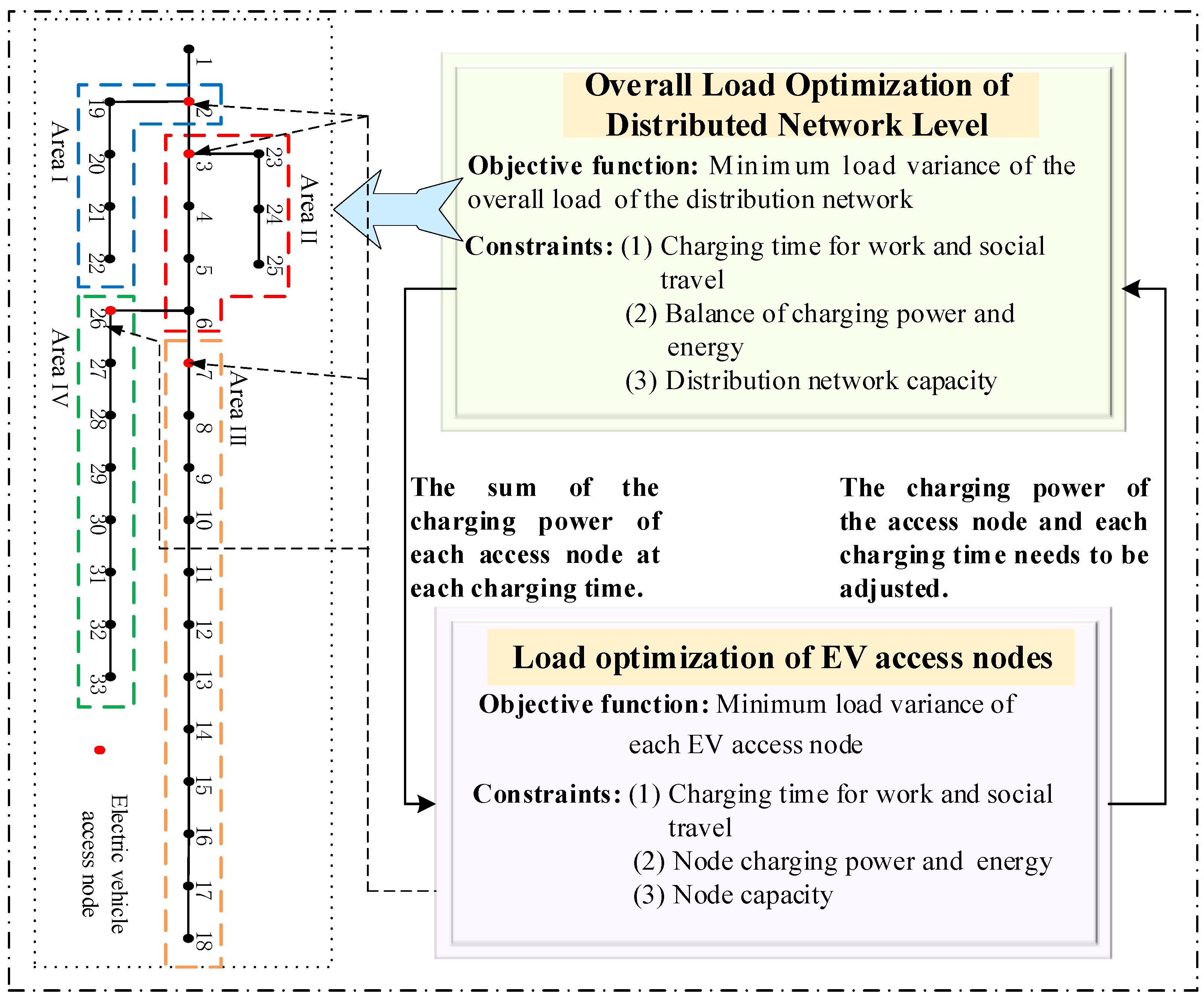
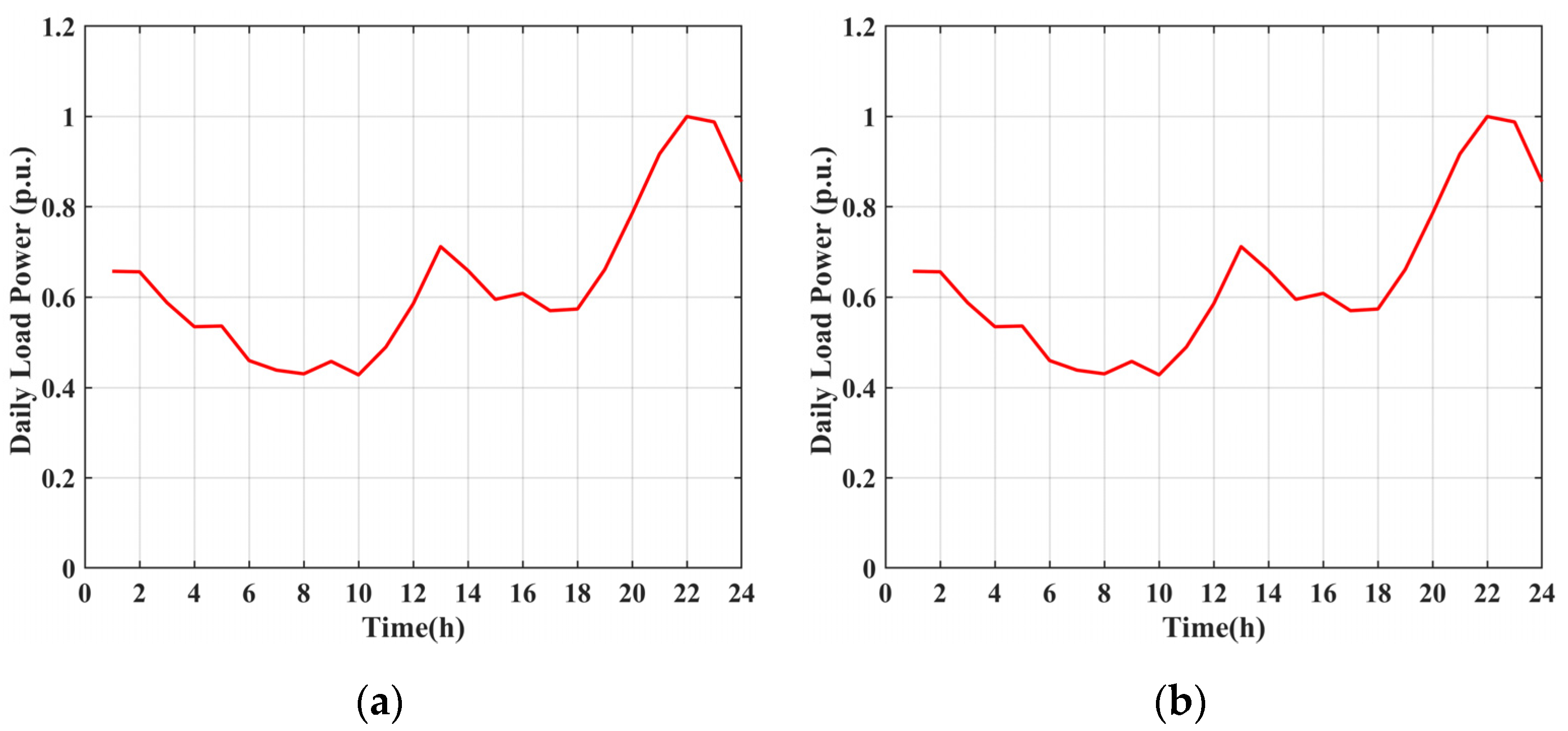


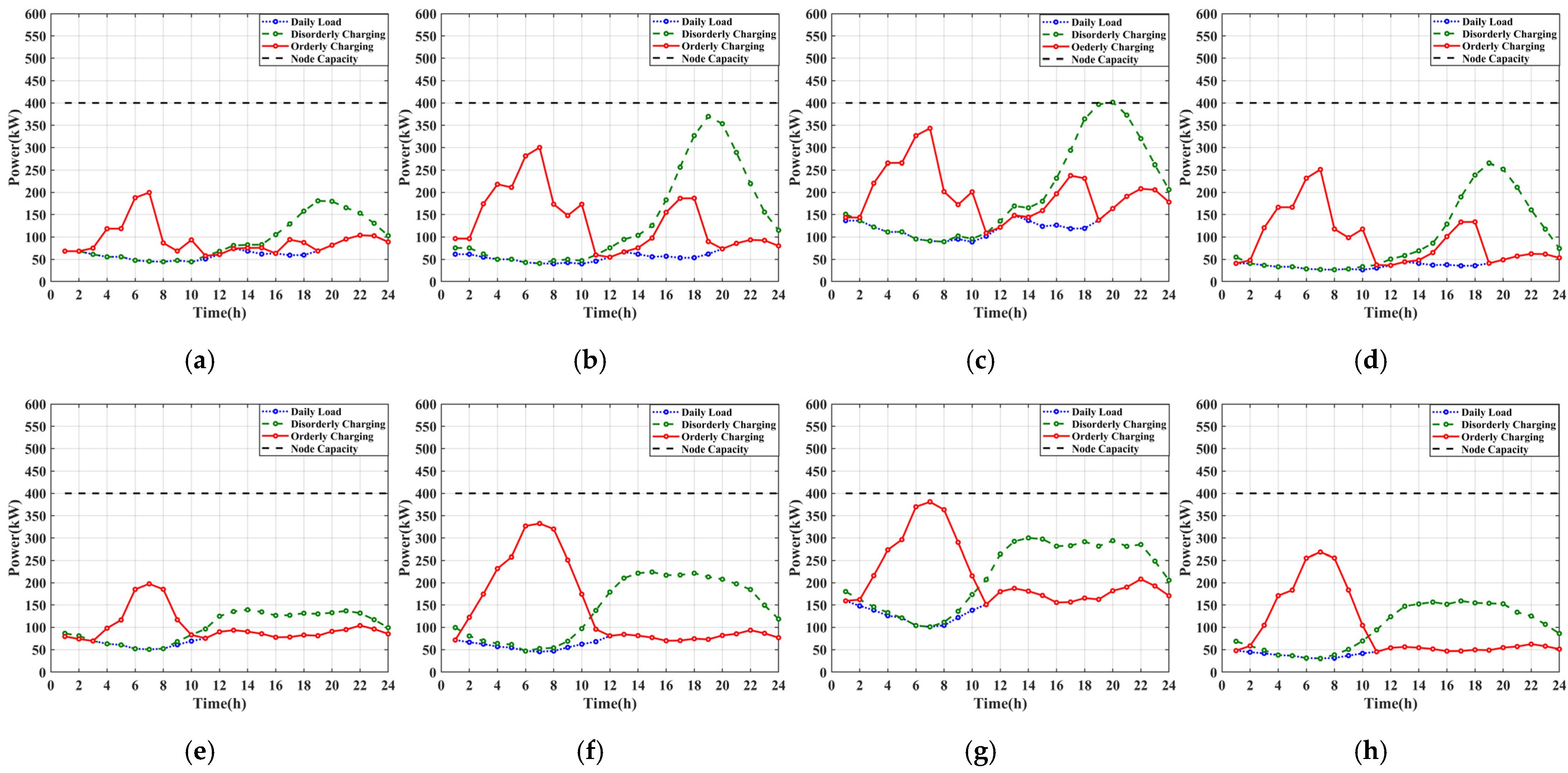

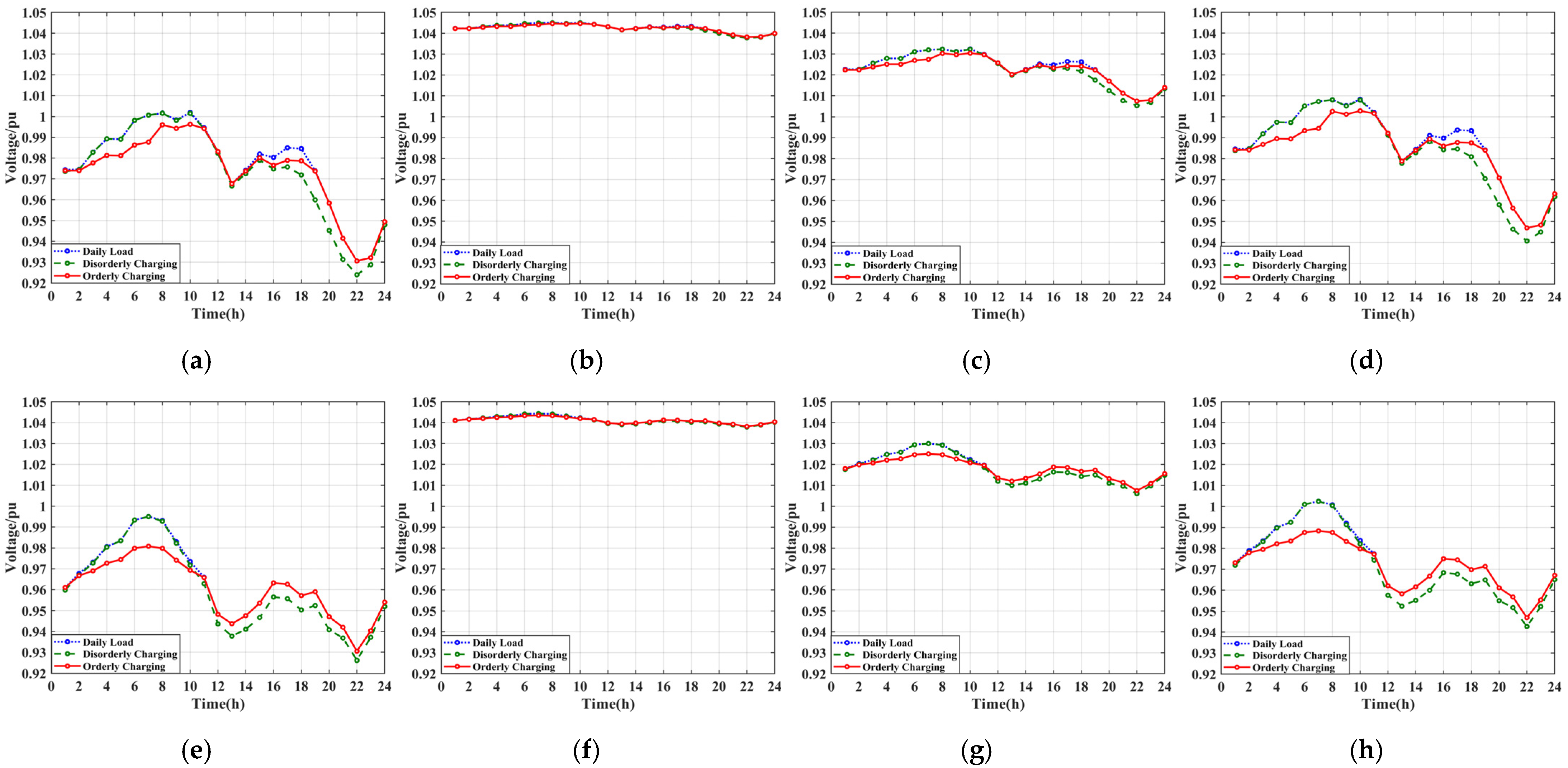
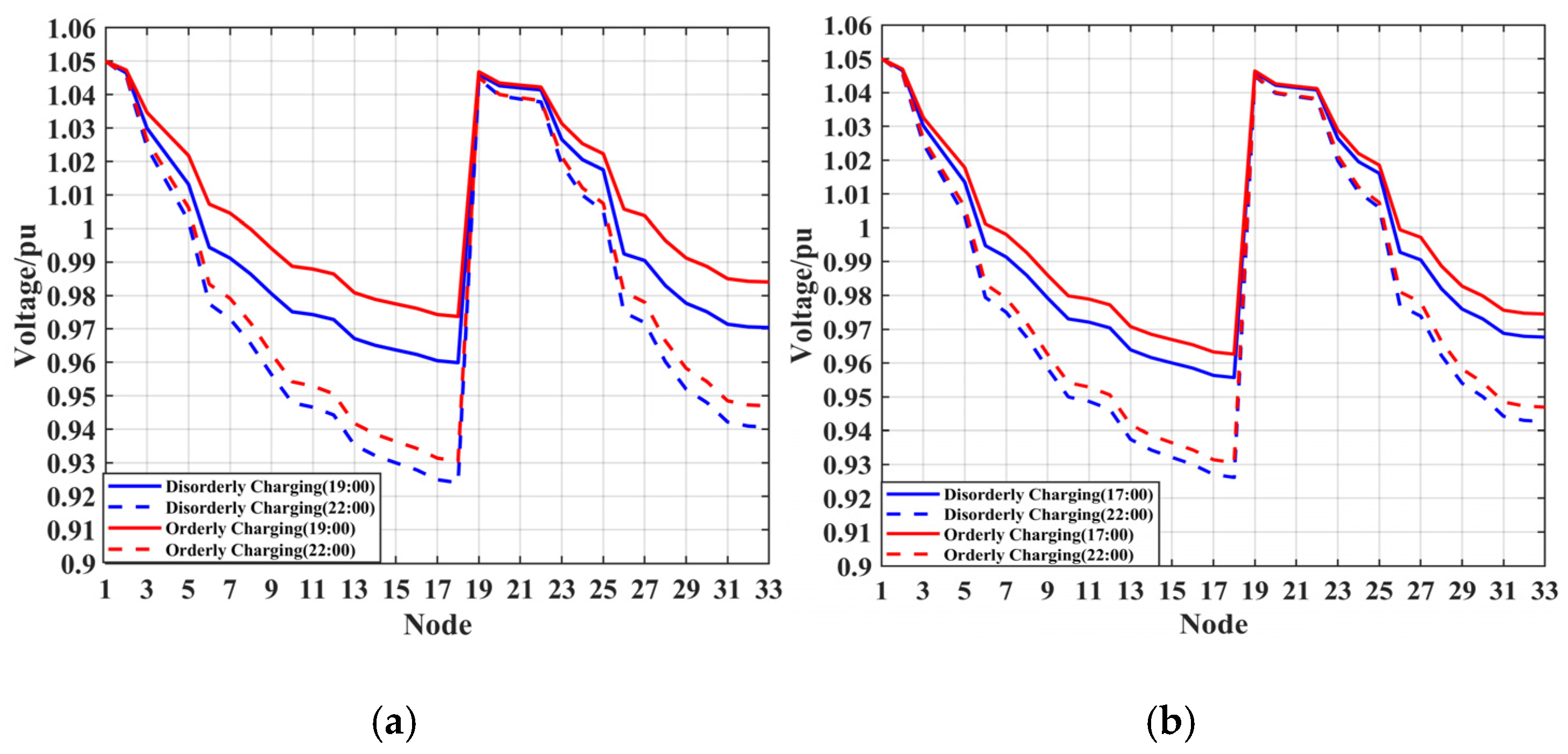
| Number of Households | Charging Power of a Single Charging Post | Number of Residents | Capacity of Distributed Network |
|---|---|---|---|
| 2000 | 7 kW | 6000 | 5000 kVA |
| Years | 2021 | 2022 | 2023 | 2025 |
|---|---|---|---|---|
| EV ownership | 168 | 260 | 373 | 654 |
| Private vehicles | 2303 | 2409 | 2495 | 2618 |
| Years | Peak-to-Valley Difference/kW | |||
|---|---|---|---|---|
| Disorderly Charging (Weekday) | Orderly Charging (Weekday) | Disorderly Charging (Weekend) | Orderly Charging (Weekend) | |
| 2021 | 2208.1 | 1949.1 | 1971.8 | 1506.7 |
| 2022 | 2285.3 | 1970.3 | 2025.9 | 1403.8 |
| 2023 | 2375.5 | 1928.8 | 2080.2 | 1277.6 |
| 2025 | 2579.9 | 1937.3 | 2238.3 | 1035.6 |
| Typical Day | Node 2 Overall Electricity (kWh) | Node 2 Charging Electricity (kWh) | Node 3 Overall Electricity (kWh) | Node 3 Charging Electricity (kWh) | Node 7 Overall Electricity (kWh) | Node 7 Charging Electricity (kWh) | Node 26 Overall Electricity (kWh) | Node 26 Charging Electricity (kWh) |
|---|---|---|---|---|---|---|---|---|
| Weekday | 2218 | 637 | 3271 | 1848 | 4716 | 1554 | 2285 | 1337 |
| Weekend | 2433 | 574 | 3395 | 1722 | 5181 | 1463 | 2368 | 1253 |
| Typical Day | Daily Electricity (kWh) | EVs Charging Electricity (kWh) | Network Loss of Disorderly Charging (kWh) | Network Loss of Orderly Charging (kWh) |
|---|---|---|---|---|
| Weekday | 58,725.7 | 5376 | 2658 | 2545 |
| Weekend | 69,066.8 | 5012 | 3499 | 3388 |
Publisher’s Note: MDPI stays neutral with regard to jurisdictional claims in published maps and institutional affiliations. |
© 2021 by the authors. Licensee MDPI, Basel, Switzerland. This article is an open access article distributed under the terms and conditions of the Creative Commons Attribution (CC BY) license (https://creativecommons.org/licenses/by/4.0/).
Share and Cite
Xiao, Z.; Zhou, Y.; Cao, J.; Xu, R. A Medium- and Long-Term Orderly Charging Load Planning Method for Electric Vehicles in Residential Areas. World Electr. Veh. J. 2021, 12, 216. https://doi.org/10.3390/wevj12040216
Xiao Z, Zhou Y, Cao J, Xu R. A Medium- and Long-Term Orderly Charging Load Planning Method for Electric Vehicles in Residential Areas. World Electric Vehicle Journal. 2021; 12(4):216. https://doi.org/10.3390/wevj12040216
Chicago/Turabian StyleXiao, Zhaoxia, Yi Zhou, Jianing Cao, and Rui Xu. 2021. "A Medium- and Long-Term Orderly Charging Load Planning Method for Electric Vehicles in Residential Areas" World Electric Vehicle Journal 12, no. 4: 216. https://doi.org/10.3390/wevj12040216
APA StyleXiao, Z., Zhou, Y., Cao, J., & Xu, R. (2021). A Medium- and Long-Term Orderly Charging Load Planning Method for Electric Vehicles in Residential Areas. World Electric Vehicle Journal, 12(4), 216. https://doi.org/10.3390/wevj12040216







